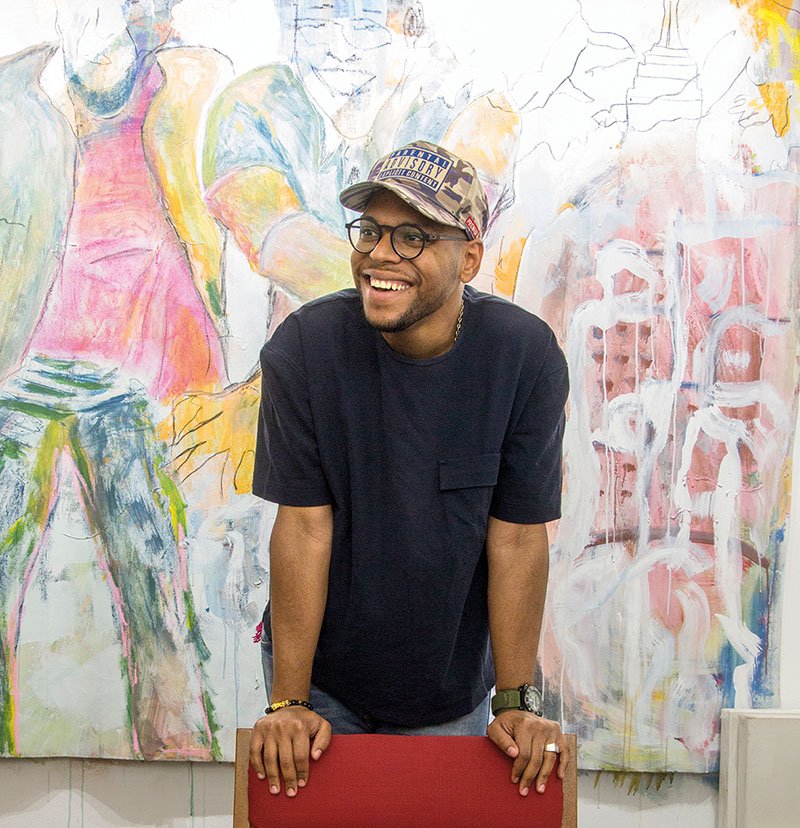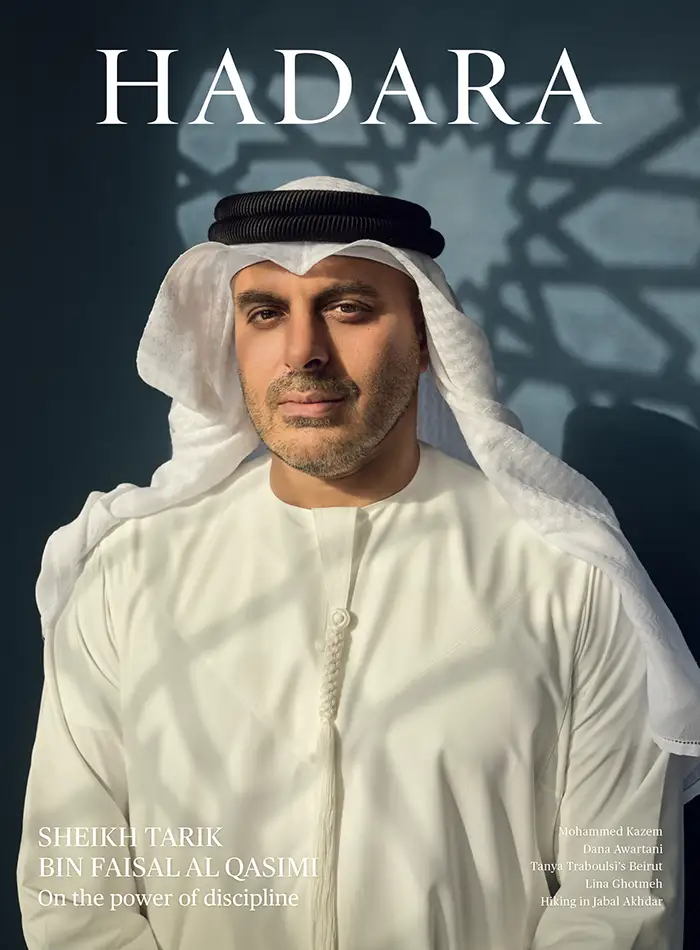The nature of things
Emirati artist Hashel Al Lamki explores the interconnectedness of humans and the natural world.
By Anna Seaman
PHOTOGRAPHS BY ISMAIL NOOR
Across six painted panels of tent fabric, which Hashel Al Lamki has fashioned as canvas, a complex narrative unfolds. Watery textures in shimmering colours rise from the heart of the nine-metre polyptych with a vivid intensity of light and a poetic, ethereal quality. On one side, a bird of prey soars overhead and pink flamingos walk beneath an enlarged sun, and on the other Cupid aims his arrow at the fluorescent heavens. This is nature, but not as we know it.
“This is a landscape shaped by phenomena such as altered rain patterns and tectonic shifts, offering a visual language that reflects the intimate and global consequences of climate change,” the artist explains.
The work, Part-Time Lovers (2024), which also comprises 20 smaller pieces painted on leather, is part of Al Lamki’s contribution to the 16th edition of Sharjah Biennial and hangs in Sharjah Art Museum until June 15. It was made in response to Amal Khalaf’s curatorial thematic Throwing Shells, which refers to a divination tradition in the coastal regions of West Africa where cowrie shells are collected and cast to access ancient knowledge and wisdom. The concept resonated with Al Lamki who continually explores the interconnectedness of humans and the natural world.
“I’m obsessed with the environment and the impact we have on it as humans,” he says. “I also think that in our fast-paced lives it is easy to forget that we are part of nature and nature is part of us.”

Header: Part-Time Lovers (2024) is part of Al Lamki’s contribution to Sharjah Biennial 16 and hangs in Sharjah Art Museum until June 15. It was made in response to Amal Khalaf’s curatorial thematic Throwing Shells. Above: The artist photographed by Hanna S. Orlowski @ HSO.Art, Cortesy of Canvas magazine.
Part-Time Lovers, so named to describe the relationship between artist, craft and subject matter, depicts both the fragility and resilience of our environment. There are shells which open to reveal shining pearls, symbols of humanity’s wisdom scattered across time and geography. And amid the swirling hues of what could be a chemically altered sea scape, a lotus flower unfolds as a symbol of strength. It is, he says, “a beautiful chaos” and “a reminder to us all to consider our role in taking responsibility for the environment.”
Al Lamki was born in Al Ain in 1986. He has always integrated environmental awareness into his practice and has often explored humanity’s dependence on and responsibility for natural resources. In 2023, he joined the Gallery Climate Coalition to acknowledge, measure, publish, and commit to reducing the carbon emissions associated with his artistic practice, and earlier bodies of work have delved into how environmental and social shifts are interlinked. “I’m fascinated by the migratory patterns of knowledge, traditions, languages, and peoples,” he says.
Painting on tent fabric, an adaptable structure linked to nomadic traditions, is a literal symbolisation of this fascination. Conceptually, Al Lamki also took inspiration from the theory of American anthropologist Edward T. Hall, which focuses on understanding cultural differences and how they influence communication, behaviour, and social interactions. The idea that we are all woven together in a fabric of existence is explored in Al Lamki’s textile installation Maat (2025), which was also unveiled as part of SB16. Installed at Al Qasimiyah School, the UAE’s first prototype for a public school, which, Al Lamki notes, is significant because it was a site of congregation and learning, Maat is an embodiment of both a personal journey and the communal search for meaning and guidance in life.

The idea that we are all woven together in a fabric of existence is explored in Al Lamki’s textile installation Maat (2025), which is installed at Al Qasimiyah School as part of Sharjah Biennial 16.
Over two years, Al Lamki travelled from the UAE to Spain, India and Egypt allowing the artwork to be defined by his engagement with vernacular cultures and “develop organically”. He describes himself as having been “seeking conceptual guidance from communities while reflecting on their histories, rituals, and traditions”. The finished piece contains material from each place, but which can no longer be defined as what it once was. Take for example cotton bedsheets that Al Lamki collected from the laundry of a luxury resort in Deià, Mallorca, during his first residency, hosted by La Residencia. The bedlinen was rejected by the resort for not meeting quality standards and began its journey with the artist. The sheets travelled with him to Munnar in India where, during a residency with the Srishti Charitable Trust in a rural plantation community in Kerala, Al Lamki used natural dyeing techniques and transformed the sheets into panels of vivid colour mimicking the vibrant palette of the earth, sky, flora and fauna. These colours then informed his paintings, and during a later, month-long residency with the ARD Art Institution in Cairo, he worked with local artisans to transform his paintings into woven and embroidered textile art. The final presentation is an amalgam of textiles, colours, shapes and form—a communal output, an embodiment not just of Al Lamki’s ideas but of his lived experiences.
“It’s a conversation about existence and a deeper search for the other, demonstrating how embodiment allows meaning to emerge from both the internal journey of the self and the external world,” he says.


In a survey show, Maqam, top, presented in 2023 in Abu Dhabi and Kochi, Al Lamki’s focus on the interplay between natural landscapes and human intervention was again brought to the fore. Missionary (2022), above. Maqam courtesy of Abu Dhabi Art; Missionary courtesy of Tabari Artspace.
These are vast concepts and complex narratives that evolve and emerge upon contemplation. Al Lamki’s practice has always straddled such breadth as he probes the impact of globalisation, our ecological upheaval, and how accelerated industrialisation alters spaces so rapidly that it warps our sense of reality and time. In a commission for the 16th Lyon Biennale in 2022, Al Lamki installed Rodinia (2022) in the rotunda of the city’s Musée Guimet. Named after a supercontinent that formed millions of years ago before fragmenting, Rodinia was an ensemble of dream-like paintings, videos, sculptures and objects telling mythical stories to explore human fragility.
In a survey show, Maqam, presented in 2023 in Abu Dhabi and Kochi and curated by Dr. Venetia Porter, Al Lamki’s focus on the interplay between natural landscapes and human intervention was once again brought to the fore.
“Rather than depicting landscapes, Hashel works within them. His art explores cross-cultural narratives and the ties between people and nature,” says Maliha Tabari, owner and founder of Tabari Artspace, Al Lamki’s gallery. “His dream-like landscapes, layered with subtlety and complexity, are mesmerising, but by integrating sustainability, social innovation, and environmental awareness, Hashel’s art goes beyond aesthetics, embodying an ethical stance.”
He is an intriguing artist who transcends generations, eras and cultures thanks to a profound interrogation of the nature of things. He weaves poetic narratives from the fabric of life, fusing the mundane and everyday with spiritual and cultural history, asking his viewers not to question their world and their existence directly but to ponder upon it, almost playfully, and in doing so see themselves, perhaps, as a piece of a puzzle, a drop in an ocean, or a beam of light from a shared sun.





